Nikon D7000 Reviews Come Too Late, Order Today
|
Update: 2010-09-27… If you’re looking to get the latest Nikon digital SLR, the Nikon D7000, you better order it today. If Nikon’s delivery history is any indication, supplies will be limited after its initial launch. Don’t wait to read the Nikon D7000 reviews to order. Grab yours today and return it if you don’t like the digital camera. Based on several online reviews of the Nikon D7000, it looks like this camera sits between the Nikon D300 and Nikon D90, possibly replacing both. It comes with some really nice features (data mirroring), HD Video and a rugged body. |
Nikon D700 Review Summary: Just Buy One. Now.
Using the Nikon D700 DSLR for the first time was a life-changing experience on par with the birth of my son. 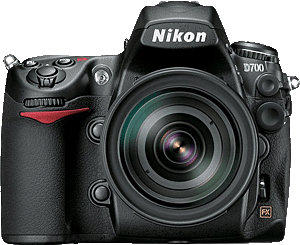 If you love photography, gave up photography when the world went digital and miss shooting with your beloved Nikon 35mm SLR camera, buy the Nikon D700 today and find happiness.
If you love photography, gave up photography when the world went digital and miss shooting with your beloved Nikon 35mm SLR camera, buy the Nikon D700 today and find happiness.
This is not a technical review but more of a commentary on what this Nikon D700 camera means to me. No brick walls were photographed in the creation of this article. If you absolutely must ogle the Nikon D700’s technical specs please read what Thom Hogan and Ken Rockwell have to say.
(I promise there is a D700 analysis here somewhere. If don’t care about how I got to the D700, skip down to the end where I tell you it is wonderful or, better yet, just buy one and find out for yourself.)
Film is Dead. Long Live Digital
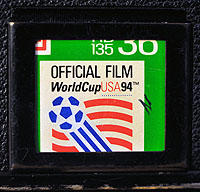 I don’t know exactly when film died but I have a guess. When I went through the family Nikon stockpile, I found this 1994 Fuji film box end on the back of a Nikon FE2. So, 1994, or pretty close to then.
I don’t know exactly when film died but I have a guess. When I went through the family Nikon stockpile, I found this 1994 Fuji film box end on the back of a Nikon FE2. So, 1994, or pretty close to then.
I can still remember shooting film after 1994 but it stopped being fun. Digital was coming. It was clunky and nowhere near the quality of film but, by 1998, the only place I wanted to show my pictures was online. Shooting film, processing, printing and then scanning was too much work.
Enter the Nikon Coolpix 950. Image quality was low. Shutter lag was measured in seconds. It could only take two frames a minute. Color reproduction was poor. In every respect, it was worse than a 1967-era Nikon F. Except, it was digital. I started shooting pictures again. It wasn’t a lot of fun but at least it was immediate.
As soon as I touched the Coolpix 950, I knew I’d never shoot another roll of film.
Cameras I have Known and Loved
My father, Ken of PBBT Fame, was a photojournalist and has been shooting for 50 years. I picked up photography from him. I have used a lot of camera hardware over the years.
While having used a lot of equipment doesn’t make me a great photographer, it does give me an idea as to what I like and dislike in camera equipment.
My first real camera was a Nikon FG-20. I used it for several years but never loved its feel — it felt small and the plastic film advance lever wasn’t nearly as solid as the metal advance on the Nikon F2. The Nikon N8008 was an amazing, functional camera with lots of technological bells and whistles but felt plastic. I took some of my best photos with the ‘8008 but it didn’t have the classic camera feel of my next camera: the Nikon FM2.
The FM2 was a real camera. It was metal. With the MD-12 motor drive, it had the heft and balance of a fine piece of photographic equipment. Unlike the older F2, it had an accurate meter and was modern enough to not to be temperamental. For being a step backwards technologically, the FM2 was satisfying for both the images it captured and the style in which it took them.
A Word About Nikon Lenses
Metal: good. Plastic: bad.
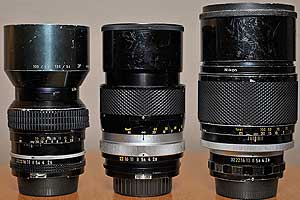 Yes, just about any plastic Nikon lens you buy today will out-perform any 1970s- or 1980s-era Nikon lens. The production quality and science of lens design and construction today is wonderful. Still, today’s lenses feel cheap. A big, heavy 180mm f/2.8 lens from 1972 (did they even have ED glass then?), with its smooth-as-glass focus ring warms one’s heart. The current generation wonder lens, the Nikon 18-200mm AF-S G-Wiz VR Nikkor Nanotaco Lens, will outperform those Nikon classic fixed-length lenses even though it is a 10x-zoom lens and half their weight.
Yes, just about any plastic Nikon lens you buy today will out-perform any 1970s- or 1980s-era Nikon lens. The production quality and science of lens design and construction today is wonderful. Still, today’s lenses feel cheap. A big, heavy 180mm f/2.8 lens from 1972 (did they even have ED glass then?), with its smooth-as-glass focus ring warms one’s heart. The current generation wonder lens, the Nikon 18-200mm AF-S G-Wiz VR Nikkor Nanotaco Lens, will outperform those Nikon classic fixed-length lenses even though it is a 10x-zoom lens and half their weight.
Nostalgia aside, today’s zoom lenses are optically awesome. Today’s Nikon Nikon 70-200mm f/2.8G ED-IF AF-S VR Zoom Nikkor lens allowed me to stop carrying a 105/2.5, 135/2.8 and 180/2.8. (I never had an 85mm or it would be gone, too.) One lens replaced three. At each focal length, side by side, the zoom produces better quality pictures. Factor in the ability to have those lengths as well as everything between 70mm and 200mm and you have a clear win for the zoom.
At the short end, too, zooms rock. My Nikon Nikon 17-35mm f/2.8D ED-IF AF-S Zoom Nikkor replaced a 24/2.8 and 35/2. If I had been fortunate enough to have a 20/2.8, it would have been gone, too.
With just two lenses in my bag, the 17-35/2.8 and 70-200/2.8, I can shoot just about anything I come across. Toss in a 60/2.8 macro and a 300/2.8 (with a 1.4x teleconverter?) and the entire photographic world is my oyster.
(As a side note, even the AI-converted Nikon 24 f/2.8 lens my father bought used in 1968 works just fine on the D700. Does that blow your mind or what? Manual-focus Nikon lenses made a decade before I was born will matrix meter on the D700. You can’t even come close to saying that about Canon and their digital cameras.)
Nikon D70 and the Age of Fun Digital
The Nikon D70 and my son were both born in 2004.
The D70 was announced in January 2004. Malcolm was due to arrive the end of August.
At long last, there was a good reason for me to upgrade from the Coolpix. The D70 was everything I wanted in a digital camera except that it was a DX-cropped camera instead of a full 35mm frame. (Basically, what that mean is that the 24mm lens and its correct angle of view effectively became a 36mm lens. Every lens I had was suddenly 1.5x longer. This is an oversimplification. Go read some technical blog if you care to know more.)
Still, I had a kid on the way and the D70 was the first digital camera that was mostly okay for under $1,000. Thanks to lowered expectations, a hard deadline and the price point, I made the jump to a digital SLR.
D70 — DX Crop Means Never Wide Enough
 If you never used a 35mm film camera with a lens wider than 35mm, you don’t care that your new digital camera is cropped by a 1.5 multiple. The 18mm-70mm or whatever zoom lens that came with the camera is plenty good at its effective 27mm view. Best of all, at the long end your 200mm lens is now a 300mm lens. All the better to shoot pictures of your kid’s soccer game.
If you never used a 35mm film camera with a lens wider than 35mm, you don’t care that your new digital camera is cropped by a 1.5 multiple. The 18mm-70mm or whatever zoom lens that came with the camera is plenty good at its effective 27mm view. Best of all, at the long end your 200mm lens is now a 300mm lens. All the better to shoot pictures of your kid’s soccer game.
I, on the other hand, wanted to be able to see 24mm of view. In fact, my 17-35mm zoom lens at 17mm is nirvana.
The D70 was functionally awesome. The color was spot-on most of the time. Image quality was good. Its crisp response was worlds better than the Coolpix. Photography was fun again and the quality was once again near film (except in low light). But, just like the FG-20 and N8008, the D70 didn’t have the right feel. I always knew I was shooting digital. I always knew the camera was plastic. I knew the D70 wasn’t a classic.
D700 Review and Commentary
The Nikon D700 is everything I have ever wanted in a camera.
Not only does the D700 meet all my technical requirements for a camera, it meets all my tactile and emotional requirements. It feels like a classic camera. 
All the buttons and knobs are in the right place. It is well balanced and crisp. The quality of design and thought involved in its creation is clear. Never do I have to think about how to do something or try to mold my mind to fit the camera. The camera is the one that changes to meet my photographic needs.
I’m sure this sounds like simple slash camera porn but the truth of the matter is that the D700 is a wonderful piece of photographic equipment.
Within moments of unboxing the camera, it simply felt right. Everything I had learned in using the D70 for four years was applicable. Yet, as I started using the camera, the camera faded away and the captured images took center stage. The viewfinder on the D700 is huge compared to the D70.
And, oh yes, the 17-35mm zoom is oh-so-wide again: 104 degrees to do with as I please. (On a DX camera, you only get 79 degrees for your angle of view.)
What Digital SLR Camera Should You Buy?
That is really simple. Today, you really have three choices and they cover the entire dollar range.
Nikon D700: Buy this camera if you like shooting wide, remember 35mm film and want the same feeling as when you first picked up any of the Nikon classic cameras. It really is the most wonderful camera I have used in my entire life.
Nikon D40: Here is the camera for you, if you love taking pictures with your Canon PowerShot point-n-shoot camera, but it isn’t responsive enough. You push the button to take a picture, the kid moves before the shutter fires and you end up cursing the day you ever bought the camera. This is the camera if you enjoy photography but you aren’t getting the results you want and need something a lot better but don’t want to spend an arm and a leg. The Nikon D40, for less than $400 with 18-55mm zoom lens (refurbished), is the perfect camera for you. Dad got one as a retirement present and is loving every minute of the camera. Honestly, at this price, you are getting an great DSLR for the price of a point-n-shoot.
Nikon D90: Let’s say you already have a digital SLR and it is getting a little old. Maybe you picked up a D100 or a D200 a few years back. You have first or second generation technology, want more but couldn’t justify buying a D300 even if it did have wonderful low-light sensitivity. Maybe you never shot film or, if you did, you really don’t care about angle of view. You want the best DX digital camera on the market today. The Nikon D90 is a year newer than the previous champ, the Nikon D300. While a year may not be a lot of time for some products, in the rapidly advancing world of digital cameras, a year is forever. For about what I paid for the D70 ($1,000) four years ago, you can get today’s top of the line digital DX SLR.
Notice Anything Missing in this Review?
I didn’t mention megapixels once. Here is the reason: megapixels ceased to be a factor when cameras passed the four megapixel mark. For anything up to an 8×10 print, four or six megapixels are fine. The D700 has 12 megapixels but that wasn’t even a factor in my purchase. More megapixels just mean I need more RAM and more disk space. I’d be perfectly happy with a six megapixel D700.
Got questions? Wanna express your undying love for a camera? Comment below.

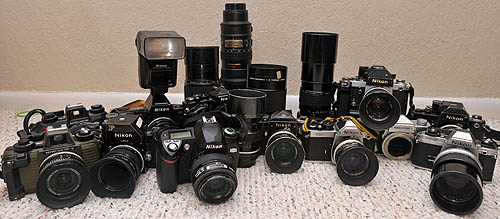
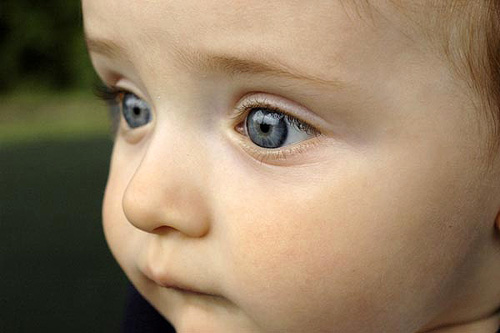
Now I know where all my old equipment went. Many of the dings and scratches on the lenses in your pictures were earned covering fires, floods and famines (mostly my own).
I’ve never owned anything more dependable than my old 1969 Nikon F, bought used for $150 and carried as my crash camera (I’d keep it in my lap for takeoffs and landings). It was completely manual, didn’t have a meter and didn’t take batteries.
It – and I – fell out of a pickup truck into flood waters and it still took good pictures for another 20 years.
You didn’t give yourself credit for surprising me with that D40 for my retirement. I don’t want to see your new camera, because the D40 is enough of a step up that I’ve rediscovered the joy of photography again.
And, yes, my standard lens selection was 24mm, 105mm, 180mm when working close and 24mm, 180mm and 300mm (or 500mm) when shooting sports.
I’m going to guess that 60% of my pictures have been shot with a 24mm or 105mm lens. I REALLY miss the 24mm format. It was the perfect length for environmental portraits at a conversational distance.
That closeup of Malcolm is my all-time favorite. I have it as my startup screen on my Garmin Nuvi 760 GPS.
BTW, I was always amused when someone would come up to me and say, “I like your pictures. You must have a really good camera.”
I’d reply, “That’s like going up to a concert pianist and saying, ‘That was really pretty music. You must have a really good piano.'”
I went digital only a couple of years ago. For me the best part is being able to take just 1 or 2 photos and then send them to someone. I remember processing a roll of film after Christmas (in my pre married years) and it also had the previous Christmas photos on the same roll, along with the previous Christmas girl friend. Current GF pickup the film from Walgreens. Not a pleasent evening.
I remember reading an industry survey saying that a “heavy user” was someone who shot 12 rolls of film a year.
I usually shot that many rolls a day.
The bulk of folks were like you: lapping holidays.
I am jealous of your D700, but you didn’t tell me why I should put my new D60 on the shelf just yet.
As you said, don’t need the megapixels. D60 works with the old glass. And gosh, it is small and light and has those tremendous new plastic lenses.
And, let’s face it, you need the comment activity.
cmk
I think you should get a D7000 so you can pass your old D700 down to me, just like you’re going to do with your Cannondale touring bike.
Although, I got introduced to a Surly Long Haul Trucker while I was in Cape. I’m going to do some research. That looks like a lot of bike for its price.
Chuck, your Nikon D60 doesn’t work fine with old glass.
The D60 won’t meter with manual glass. And, by “won’t meter”, I don’t just mean won’t 3D color matrix meter. I mean the D60 won’t even center-weight meter using glass without a CPU. That makes your D60 less functional than a 1965 Nikkormat. I mean, really, what fun is a camera if you have to carry an external light meter?
The other problem with your Nikon D60 is that it requires AF-S lenses. Some of the best fixed-length glass available today (85/1.4, 28/1.4, etc.) is unavailable in AF-S. They are available as autofocus only and require the screw-drive that the D60 (and D40 series) lack.
The D60 also has a slow, 1/200th flash sync while the D700 will sync up to 1/320th. For daytime fill flash, the extra headroom of the D700 is much appreciated. (The D40 has a 1/500th flash sync, by the way, making it totally awesome.)
The D40 is $350 less than the D60 and the only thing you are giving up is meaningless megapixels. I’d rather have the D40 with its stock 18-55mm lens and then take that $350 savings and spend $230 of it on the 55-200mm lens.
Besides, the D60 feels small and plastic.
—Matt
I never did like to use fill flash. Actually, I hated to use flash at all.
I carried small, high-wattage bulbs that I’d stick in existing light fixtures to bump up the ambient light. It had an advantage: once the subjects got over the momentary surprise at how bright the room was, they reacted normally. After all, the light was coming from the same place that it always came from, there was just more of it.
My theory was that if God had wanted to light the world with flashes, he’d have used lightning, not the sun.
When you use strobes, the subject has a Pavlovian response: the flashing lights offer feedback; he’ll either keep making that action or he’ll avoid the action that caused the light to go off.
You get used to a steady light source, you don’t get used to flashing lights.
Thanks for the info on the new Nikon. It is a little pricey for me. I am considering an entry level. Do you think DSLR cameras are worth the price? Is the quality really that much greater than point and shoot? I found this site http://www.dslrcamerareviews.com that gives some info on them. Just trying to decide whether to buy a DSLR or point and shoot. Thanks for any advice. Thanks
It all depends on what kind of shooter you are. My youngest son is a put-the-camera-in-my-pocket-so-I-can-shoot-quick-pix-of-my-friends shooter.
Portability and ease of use are tops with him.
I spent most of my life as a pro and liked many features of the point-and-shoots I tried, but I was frustrated because they didn’t give me exactly what I saw and they didn’t give it to me WHEN I wanted it. They were more like point-and-shoot-sometime-in-the-future.
My wife likes her Canon P-&-S because it slips into a pocket in her purse and shoots videos of the grandkid.
So, the answer is, there is no right answer.
Joncmac: The entry-level D40 ($375 and that includes the lens) is an awesome camera for money. It is ten time better than a point-n-shoot digital for less than twice the price. Buy it and don’t look back.
That said, the best camera in the world is useless if you aren’t carrying it when you want to take a picture. If you’re not willing to carry an SLR, don’t buy an SLR. You’ll get a lot more good pictures from a point-n-shoot that you carry with you everywhere than a DSLR that you leave at home.
If you have a few cameras on your short list, let us know and we’ll see if we can narrow it down a bit further.
—Matt
joncmac,
Matt makes a good point. My brother, Mark, has an iPhone. I don’t like ATT Wireless (I was a telecom manager who moved 300+ phones from ATT to Verizon because their service sucked) and I’m not fond of iPhones because of the deal Apple cut with ATT for exclusive rights.
Having said that, I’m impressed with the pictures he’s taken with it. There’s a lot to be said for always having a half-decent camera in your pocket.
My D40 is a bit of a pain on the back of a bike, but I appreciate the improvement in quality enough to put up with the inconvenience.
My whole shooting style changed with the D40. A P&S camera leads to pointing and shooting; a DSLR makes you want to compose the picture and diddle around with exposure settings so you wind up with a picture that matches what you saw in your mind.
The reason cell phones have cameras and those cameras keep getting more megapixels is so the phone companies can sell more bandwidth.
Even a teenage girl can only talk so many minutes a month. To really maximize network usage (and revenue), telcos gotta increase the data density. Doubling the cell phone’s camera’s megapixels quadruples the file size which means having to upgrade your cell phone plan.
—Matt
Matt,
Gosh. Remind me not to piss you off again.
Yeah, you are right that the D60 won’t meter with the old glass. But, remind me please, who needs a meter? F8 and be there, right.
I just stuck a 105 Nikkor, serial number 684398, on the D60 and shot properly exposed photos both indoors and outdoors using common sense and a quick correction based on viewing the little photo they make instantly available on the back of the camera.
The D60 is small. That’s one of the things I like about it. And it doesn’t feel plastic, at least not to me. It feels even better with the old glass in place.
I’m not saying your advice to get the D40 for the bang to buck is not valid. I’m just saying I like the D60.
But pardon me. I’ve got to run an errand. I heard they have a D700 at the camera shop in the mall.
See ya.
The D700 is now selling for $300 less than I paid thanks to some special Nikon rebates. (Oh, if only I had waited another week.) That is probably the best offer you’re going to see through the end of the year. If you’re serious about buying the D700, there is really no reason not to buy right now.
—Matt
I’ve used Nikon equipment since the early 70s, had two stolen and have three left over. I finally bought a D-90 last December and am in love with it. I remember the photographers at the newspaper where I worked before retiring me telling me that they liked the digital cameras because they could preview their shots in the field. I know what they were talking about now. I’m still learning about the D-90, but it’s a great piece of equipment. And I’ll probably still hang onto my film cameras.
Ken,
Like I’ve written in a couple of places, my D-40 is a great camera bike when I carry it in a Arkel small bar bag.
If you’re into photo stuff, check out my review of the Domke shooting vest. I really like it.
http://www.palmbeachbiketours.com/domke-photo-vest-lives-up-to-expectations/
I felt the same way as you when I picked up my new D700.
My camera ownership is a bit different, and less interesting, than yours. I started in ’97 on a Minolta Maxxum 7000, then bought a Nikon F100 and a 20-35mm f2.8 (the precursor to the 17-35mm) when I started at my first paper. The association of that setup to actually being paid to do what I love is the foundation of photojournalism to me.
The first digital body I owned (not just used for where I worked) was a Nikon D2h (6mp really is all you need). And although a very nice camera it’s much different after knowing what you’re giving up with film.
In March I was able to pick a D700. After throwing my 20-35mm on it I was back to my roots. No more sacrificing to have immediate results. I have my full frame, I have my “film” I can push if needed (2000+ iso is wonderful) and I have my small body that doesn’t intimidate little kids. (plus all the benefits of being digital)
J. Langlois,
You might be interested in seeing the same subject shot on 4×5 film in 1964 compared with the digital version I took the other night in 2009.
http://www.palmbeachbiketours.com/digital-photography-vs-large-format-silver-film/
I enjoyed reading your blog! Honestly. It was very informative, yet candid and humorous.
I have a D60. I, too, bought it because a little bundle of joy was making a grand entrance soon. And, I love it! Have always and will always, probably … until my toddler discovers that it makes a nice shattering sound when thrown on the floor.
Your love for the D700 is so convincing. It’ll be my pick when the dreaded camera-shattering day arrives.
You didnt say anything about the D300s? Its 1000 bucks cheaper than the d700. How does it hape up?
Robb, the Nikon D300s is a great camera and has similar electronics to the D700. What it lacks is a full-frame (FX) sensor. So, wide angle lenses aren’t really wide on the D300s. That’s the problem I had with the D70.
If you’re someone who shoots primarily with a telephoto lens, the D300s is a better choice than the D700 because you get 1.5 times the focal length for, effectively, free. A 300mm f/2.8 lens will function, effectively, as a 450mm f/2.8 lens. That’s pretty darn sweet.
For me, however, I more value shooting wide. For that, the D700 (and other full-frame cameras) excel.
Two years later, I still love my D700 as much as the day I purchased it and have hundreds of good photos to show. Of those hundreds of good photos, I have a dozen great photos that I do not feel I could have shot with any other camera.
The low light abilities of the D700 still shock and amaze me. Last month I shot a picture in a cave at 1/2 of a second, f/2.8 at ISO6400 and the grain/noise and detail is better than what I would have expected from ISO 1600 negative film.
Cheers,
Matt
thanks for good review guys.
i have bookmarked for future referrence !
I really like nikon and i think the same about D7000.
@Matt…… which one do u prefer is the best cam?
My wife and I are bent on purchasing our very first DSLR. Yep, we’ve survived through these technology-driven years with just our handy digicam in tow. Ad it’s not even the modern kind. Your article has given us some great pointers. Thanks, Matt!
Any of the DSLRs will open up a new world for you. You’ll take real pictures instead of waving a point-and-shoot around at arms length spraying and praying that you get some kind of image.
Who could have known that the birth of our daughter is the only way in which I could finally own my very first DSLR? My wife, for the longest time, has been very much opposed to it, seeing DSLRs merely as boys’ toys. She stepped over to the other side when she saw the quality of the photos that my brother (who owns a DSRL) produces compared to ours. This nesting phase for pregnant women suits me well! ;)
Yes, long live digital, indeed! :) I had a hair raising experience a couple of months ago when my dad placed a bet that I would not survive a day without my DSLR. I accepted his dare and armed myself with his old (really old!) Pentax during a nephew’s birthday party. Whew! I never thought that not being able to view your shot right after you took it would be so stressful!
Cheers to all the old-timers out there! :)
Chimping! I’m guilty of that — although I’m not really sue if this is a good or a bad thing for a photographer to do. I just can’t keep my eyes off the LCD screen right after I take a shot.